Looking Back At The DEATH WISH Franchise
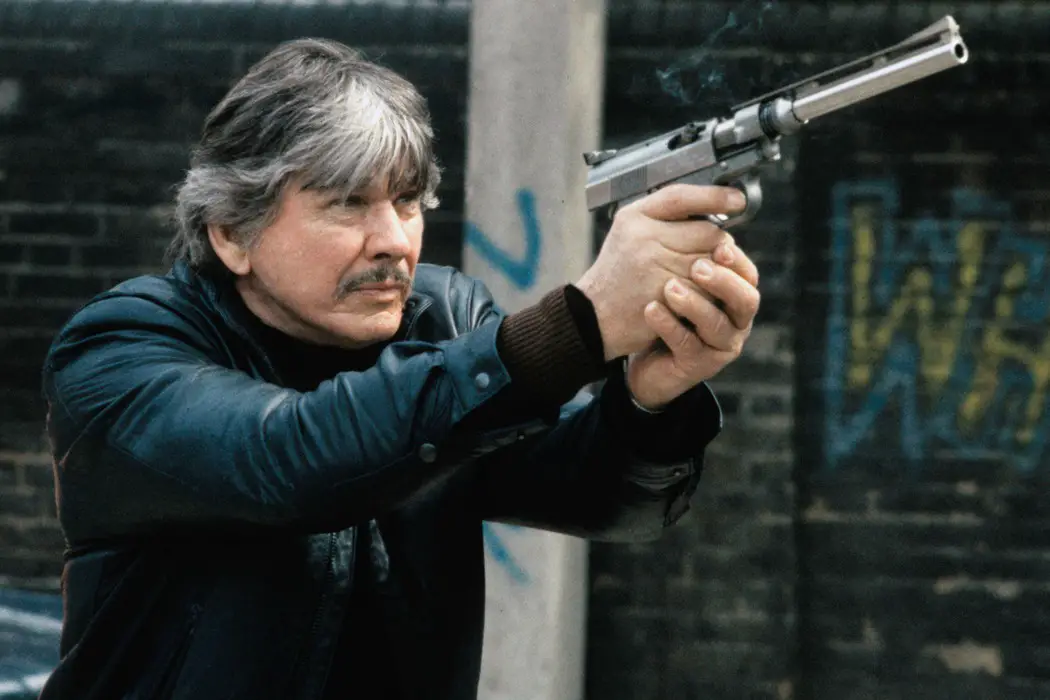
Alex is a 28 year-old West Australian who has a…
When it comes to examining film genres, there’s always the one film that perfectly encapsulates the different qualities of that particular sub-genre; you’ll often notice they are the go-to titles when trying to pitch a film or recommend something to people. Die Hard is often referred to as the perfect action film, due to its efficient story-telling and entertaining action set-pieces. The vigilante sub-genre, narratives which depict the vengeful or illegal recourse of a revenge seeking protagonist(s), was captured by Michael Winner’s sleazy but effective crime thriller Death Wish. Every revenge or vigilante picture is always referred to as “Like Death Wish but-”, due to the genre touchstones that it introduced. These qualities include: a citizen or everyman who is unfairly attacked/related to someone who is assaulted (in a variety of fashions), a one man army who works outside the law to the scorn of the police and a high body count.
Much like the Die Hard and Rambo franchises, the original Death Wish is drastically different to the various sequels that came out sporadically over a 20 year period. Just look at the evolution of the Rambo franchise, the general pop culture perception of Rambo is that of the alpha 80’s masculine hero, a personification of the pissed off conservative American, one disenfranchised by Watergate and the failures of the Vietnam war, seeking an antagonist in a complicated world which doesn’t offer a simple solution.
With a large arsenal of absurd firepower, Rambo wages several one man wars against ambiguous foreign countries, each one representing the current American political crisis, dealt with in a violent and shallow manner. This is a far cry from First Blood, Ted Kotcheff’s heartbreaking profile of a lost Vietnam vet, examining the unfair treatment of the returning American soldiers after the upset of the Vietnam war. Despite the film’s use of violence, the film was more of a character study of the protagonist John Rambo, a man who gets unfairly thrown into a crappy situation and fights to gain his humanity through the only way he’s been programmed to – violence.
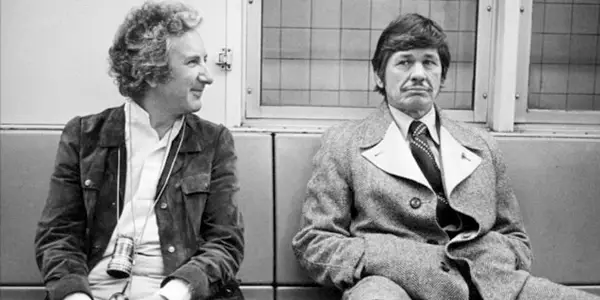
Compare this to Death Wish, the franchise which gave action star Charles Bronson one of his most well-known roles, the vigilante architect Paul Kersey. Looking at Winner’s 1974 original Death Wish and the eventual 5th sequel, Death Wish 5: The Face of Death in 1994, the 20 year difference clearly shows in every department, just not the greying hairs on Bronson’s trademark mustache.
What started off as a grounded drama with mild genre elements, a deconstruction of an everyday civilian who feels he is morally forced to fight against the growing levels of dangerous street crime, slowly descends into a series of 4 sequels which proceed to get more sleazier, violent and absolutely absurd, ending with Kersey pushing a corrupt businessman into a vat of acid in Death Wish 5.
Death Wish (1974)
Made during one of the most prominent years of the American New Wave movement, 1974, Death Wish was a cathartic experience for American civilians of the time. Based on Brian Garfield’s 1972 novel of the same name, Death Wish was one of the first American films to advocate the idea of vigilantism, due to the growing number of street crime, political corruption and lack of significant change being made by those in power.
Back when cinema had the power to induce political conversation in the media (nowadays it’s just controversy talk, like last year’s Ghostbusters dilemma), Death Wish was highly controversial due to its pro-vigilante stance, a big disparity from the original novel’s anti-vigilante message. Even though the film doesn’t outright celebrate the killing of criminals like the sequels do, Death Wish attempts to explore the moral complexity behind the ideas of taking the law within your own hands when you feel like the law enforcement has failed you.
Death Wish introduces us to the successful architect Paul Kersey (Charles Bronson), whose life is completely shattered when his wife is killed and his daughter is viciously assaulted in a random home invasion by a pack of violent street thugs. When the police fail to find the men responsible behind the attack, Kersey diverts his growing anger at the poor law enforcement and rising gang activity by performing random acts of vigilantism, goading criminals into stealing or attacking him so that he can kill them in self-defense.

The film explores the gradual deconstruction of Kersey, a decent family man with a well-paying job who deals with his injustices through an avenue of startling barbarity, showing the emotional and physical decline of someone who has suffered an unfortunate incident. Using the B-Movie framework, Winner manages to create a disturbing and quite effective portrait of the disenfranchised American, using the powerful tools of B-Movie cinema to entice audiences with exploitative action, punctuating it with a simmering level of thematic meaning and genuine dynamic to the story-telling. Unfortunately, this was the last time Winner attempted this type of deeper story-telling, shifting his attention towards more violent and pulpier material, stripped of any of the humanity of his earlier work (The Mechanic is another great film which mixes compelling action with a legitimate character study).
Much like the effect Taken had on Liam Neeson’s career (shifting from dramatic material towards more pulpy genre movies), Death Wish gave Bronson a significant career change. A well-established action film star, Bronson had always played the stoic but powerful protagonist, most famously in Once Upon a Time in the West, The Great Escape and The Dirty Dozen, so the idea of doing Death Wish wasn’t exactly a major detraction for him. What it did though was give Bronson’s sagging Hollywood career a much-needed boost, as he had slightly faded from the spotlight due to getting older and aging out of the typical action hero roles.
The success of Death Wish created a sub-genre of exploitative action films starring Bronson, mostly directed by either Michael Winner or J. Lee Thompson and usually produced by the B-Movie kings The Cannon Group. It also spawned a series of vigilante films which mostly followed the similar narrative formula established by Death Wish, the most well known derivatives include Vigilante, The Exterminator and Fighting Back, none which had the pop culture impact of the film which inspired them.
Death Wish 2 (1982)
Death Wish 2 immediately took the direction of the series into a very sordid and immoral direction, being possibly the darkest entry in the entire series. The infamous Cannon Film Group, (run by co-producers Menahem Golan and Yoram Globus), purchased the rights to the Death Wish name and concept from Dino De Laurentiis, the Italian producer of the original film. Golan and Globus had a tendency to re-animate old franchises/hit films in order to make a quick buck off their familiar properties. Outside of the Death Wish sequels, most of their attempts at this bombed, with a major string of failures (such as Superman 4: The Quest for Peace) leading the company to collapse in the early 1990’s.
Due to their insistence on making low budget exploitation films, Death Wish 2 allowed returning director Michael Winner to go as sleazy and deranged as possible, shedding the original film’s morally complex thematic content in favor for more explicit material. Despite there being a Death Wish sequel novel written by the original author Brian Garfield, which dealt with a wave of copycat vigilantes emerging after Kersey’s actions in the first story, Cannon chose to create their own original plot-line, stating “We think our movie is a better film story”.
One of the more unique narrative elements from the first Death Wish was, despite being a vigilante revenge picture, Kersey actually never tracks down or finds the gang members that killed his wife and raped his daughter. His apprehension of criminals is very random and loose, a violent expression of his anger at the rising street crime at the time. Death Wish 2 is quite similar to the sequels Rambo: First Blood Part 2 and Die Hard 2, which are more violent clones of the original films that establish all the pop culture touchstones and narrative mechanics for the rest of their respective series. Die Hard 2 featured John McClane saving the day again, but the climax is much more over the top (blowing up a plane) and McClane is forced to team up with a wise-cracking partner (which became a repeated motif throughout the rest of the series). Death Wish 2 simply copies the basic formula of the first film – Kersey is a decent, well-adjusted man who is pushed into becoming a vigilante when someone close to him is hurt/killed by gang members in a random act of violence.
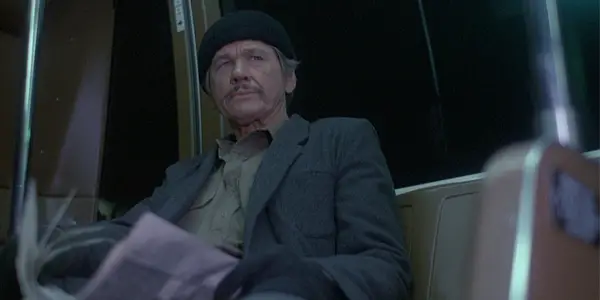
Whereas Death Wish actually tried to explore the more deeper and complex issues of illegal vigilante activities, Death Wish 2 is quite a generic and straightforward revenge film – 5 gangsters target Kersey for absolutely no reason, killing and raping both his maid and his traumatized mute daughter. Due to a lack of evidence, Kersey hunts down and kills each 5 members responsible. It’s quite a simple story, but should we expect anymore from a Death Wish sequel? Despite screenwriter David Engelbach’s remarks that he raised several “serious issues”, such as the criminal justice system and the rise of street crime, the film definitively turned the Death Wish franchise into a vehicle for Bronson to shoot punks, a cathartic experience for the audience who themselves felt they were being slighted by a corrupt political system and a rise of street crime.
Even though none of the Death Wish films addressed his advanced age, he was usually paired up with an attractive actress in her 30’s (when he wasn’t acting with his real life wife Jill Ireland), adding to the idea of Kersey as the male power fantasy, a charming man who constantly kicks ass, deals out lethal justice with zero consequences and is unanimously celebrated by the community. Despite this, Death Wish 2 attempted to deal with an alternate look at vigilantism, through Bronson’s radio announcer love interest Geri (Jill Ireland), but its a subplot largely relegated to the background, crowded by the film’s frequent bouts of graphic violence. Despite poor reviews, the film did quite well domestically and internationally, gaining a rare profit for the constantly failing Cannon Film group. This meant that a third film was inevitable, which didn’t come for another 2 years, as Winner went off to direct another exploitation film for Cannon (The Wicked Lady) and a TV Movie (Scream for Help), both which failed commercially. In the meantime, Bronson made another title with J. Lee Thompson (Murphy’s Law, a film with a great trailer), his most frequent collaborator, (they ended up making 9 films together), a mild success which didn’t hit as big as Death Wish 2 or 3.
Death Wish 3 (1985)
Where Death Wish 2 was dark, gritty and reveling in its disgusting affairs, Death Wish 3 once again took the direction of the franchise a totally different way. Despite the violence being escalated tremendously, Death Wish 3 transforms the tone of the series from an unpleasant ferocity into a carefree goofiness which is much more lighter and fun than the previous entries. Visual changes include frequent scenes shot during the daytime (as opposed to the nighttime settings of the past 2), a vibrant color palette and an amusing negligence towards the realistic vibe that had been one of the series’ trademarks. It’s best to look at Death Wish 3 as the most violent comic book adaptation ever made, with its exaggerated camera angles and aggressively campy visuals giving off the vibe of the Joel Schumacher Batman films or Rachel Talalay’s Tank Girl.
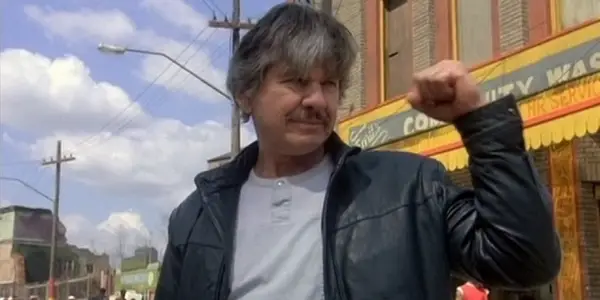
Much like the typical Western pulp fiction, Death Wish 3 sees the lone gunman walk into a new town that has a gang problem that must be stopped by this mysterious newcomer. The plot sees Kersey moving to another town to escape the backlash of his actions from Death Wish 2, deciding to live in an apartment with his old Korean war friend Charley (Francis Duke).
Coincidentally as Kersey is on his way, a gang of punks (including Bill and Ted’s Alex Winter) break into Charley’s apartment, senselessly murdering the innocent man, and then found by the newly arrived Kersey. Due to being found with the dying man, the police accuse Kersey of murder, where he meets frustrated policeman, Richard Shriker (Ed Lauter). Shriker decides to use Kersey’s vigilante past to his advantage, making a deal with him that he can kill any gang member he likes, as long as he obtains some valid intel on the gangs. Now with a license to kill, Kersey teams up with an apartment building of pissed off seniors to start a war against the extreme gangs that rule the streets.
Whilst the first 60 minutes of the film are enjoyable enough, it’s the film’s insane final 20 minutes that makes it so memorable. After a series of gang members are killed by Kersey, the gang fires back in an unruly fashion, with an entire army of hundreds of random gang members killing anyone in sight. This triggers a mini urban war outside of Kersey’s apartment, which sees Kersey and Shriker killing a ridiculous amount of violent criminals, using a mini-gun, pistols, molotov c*cktails and finally a bazooka. It’s truly one of the greatest third acts in action film history, a gleeful display of remorseless violence that gives into every guilty desire that we wish would occur when we start watching exploitation cinema.
The unhinged direction of this film recalls the sense of surprise and guilty joy that the latest Mad Max film brought, the feeling of “I don’t know what the hell is going on but I love it”. With Winner’s two previous films bombing quite badly, Winner needed another hit in order to keep his sagging career afloat. Choosing to team up with Cannon again, (who had Bronson under contract), Winner decided that Death Wish 3 was a sure-fire hit due to the minor financial success of the previous sequel. Thanks to the success of the prominent Rambo franchise, Kersey was retooled to become more of a macho-action superhero, an unflappable man’s man who deals justice with a variety of overpowered firearms.
Death Wish 4: The Crackdown (1987)
After having a difficult time with Winner during the production of Death Wish 3, Bronson sought a new director to shoot the inevitable 4th Death Wish film. After 6 successful collaborations, Bronson personally chose director J. Lee Thompson, as he admired the director’s tight and efficient film-making style, never demanding more than two takes and always making sure the film was made on time and under budget. Once again made by Cannon Films, (whose financial situation was getting much worse, mainly due to the big budget flop of Roman Polanski’s Pirates), scriptwriter Gail Morgan Hickman was picked to write the film, who chose to do a mafia-themed interpretation of the classic Yojimbo narrative.
Usually characterized as the lone protagonist who tricks two opposing armies to fight each other in order to wipe them both out, a plot-line which is based on Akira Kurosawa’s classic samurai film Yojimbo. This is a narrative frame that has been used hundreds of times since Yojimbo’s release, most notably in Sergio Leone’s A Fistful of Dollars and Walter Hill’s Last Man Standing.
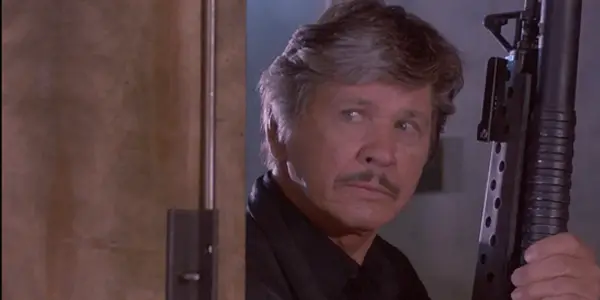
Death Wish 4: The Crackdown doesn’t really do anything new with this material, having Paul Kersey be the igniting spark that triggers a war between two antagonistic mafia families, but for a Death Wish film it has a surprisingly solid story. Whilst all the familiar Death Wish elements are present – Kersey’s love interest is killed, Kersey is exploited due to his vigilante background and a high body count of criminals occur, Death Wish 4: The Crackdown hangs these elements onto a decent, albeit predictable, narrative, which is why it is considered one of the better Death Wish sequels.
The longest entry in the series (which is only one hour and 40 minutes), J Lee Thompson shoots the action efficiently, Bronson maintains his old-school badass charm that makes him so engaging to watch and the film avoids the sleazier parts of the early Death Wish films. Whilst it is no masterpiece and there is plenty of better action films at your disposal, for a 4th Death Wish film made by the Cannon group starring a 67 year old Bronson, it’s much better than one would expect. On a budget of $5 million, the film only procured a lowly sum of just under $7 million, adding to the large list of financial failures for the Cannon group who were on the verge of collapsing.
Death Wish 5: The Face of Death (1994)
Face of Death could be an incredibly ironic title because oh boy, does Bronson just look completely miserable in this one. Instead of leaving the franchise in a somewhat respectable fashion with the 4th film, Death Wish 5: The Face of Death was made as a desperate attempt to make some money for 21st Century Film Corporation, a lousy film production company made by Menahem Golan after Cannon Films officially went bankrupt.
Shot on a budget of $5 million, with roughly 90% of that going towards Charles Bronson’s salary, the movie is a cheap looking TV film which feels absolutely nothing like a Death Wish film. Shot in Canada by a dramatic TV director (Allan A. Goldstein), the film was the first in the series to be primarily shot in a studio, rather than on location, which contributed to the film’s subpar aesthetics, which is noticeably bad for even this franchise. These visuals just highlight how lazy and unnecessary the whole thing feels, but unfortunately this would be the last theatrical film of Bronson’s career, before his death in 2003.
With this entry, Charles Bronson wanted the character of Paul Kersey to be less violent, being more of a kind figure who avoids violence rather than perpetuating it. Mixing this with Goldstein’s lack of action film-making experience and paltry budget meant that the film is extremely light on the exploitative violence, one of the franchises most enticing trademarks. Gone is the anger-driven vigilante justice delivered by the barrel of an over-sized firearm, replaced by a remote-controlled soccer ball that blows up a mafia hitman, paired with a lame one-liner that would sit comfortably within a Marvel Superhero film. The only positive point that can be given to this film is that it is also the only entry in the series that doesn’t feature a rape scene. So at least it has that going for it.
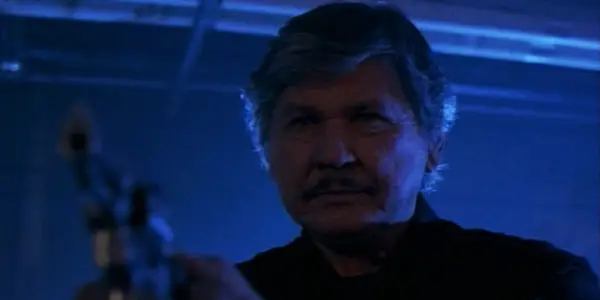
Death Wish 5: The Face of Death has Kersey returning to his hometown of New York (you’d never know tho, due to the high amount of interior studio shots) under the protection of the Witness Protection Program, finding love for the fifth time with successful fashion designer Olivia (Lesley-Anne Down). When Olivia starts to get harassed by ex-husband mobster Tommy (genre favorite Michael Parks), she is forced by the authorities to finally testify against him so that they can arrest the highly elusive gangster. When Tommy finds out, he kills Olivia and kidnaps their daughter, so it is up to ex-vigilante Paul Kersey to get revenge for his newly deceased girlfriend (again) and take down Tommy’s criminal empire. Where one might expect Kersey to take down hoards of mafia associates, much like Death Wish 4: The Crackdown, the film instead feels like an adult version of Home Alone, with Kersey setting up a series of elaborate pranks to kill his enemies, for reasons that the film never explains.
A sad final film for the cinematic icon Charles Bronson, Death Wish 5: The Crackdown was a critical and financial failure, with many pointing out how tired the Death Wish premise was and Bronson’s advanced age made his action scenes hard to take seriously anymore (which could account for the silly death scenes). Despite this, Golan tried to make a 6th film, Death Wish 6: The New Vigilante, which would be a passing of the torch for a new protagonist to take over the already dead franchise. Plans for these obviously fell through, with Golan’s 21st Century Film Corporation closing down shortly after this films release.
The State of Death Wish
With horror director Eli Roth currently in production of a Death Wish remake starring action icon Bruce Willis, we could see a whole new wave of vigilante movies flooding the exploitation cinema scene. Despite them popping up occasionally, the vigilante genre isn’t quite as hot as it used to be, despite the sporadic hit (John Wick) keeping the spirit alive.
Films which act as a cathartic release for the repressed everyday civilian is now the Superhero genre, the 21st Century male power fantasy, a series of characters who use their advanced skills to combat political and supernatural threats. These films have essentially replaced the idea of the typical American action film, one which evolved from the stereotypical military character, to the vigilante everyman in Death Wish, now to the adventures of the Avengers.
With a series of incredibly eclectic films, the Death Wish franchise is one of the most unique action franchises to ever exist. Giving Charles Bronson his most well-known role, Paul Kersey, the vigilante architect, the Death Wish franchise effectively kick-started and ended the vigilante sub-genre that was highly popular throughout the 1970’s and 80’s. It definitely summaries the qualities of the vigilante sub-genre so much that it’s become the touchstone when referring to any film similar to it – Law Abiding Citizen, Taken, John Wick, Man on Fire and more, all owe a little debt to the twisted legacy that Bronson’s franchise has left behind.
What do you think of the Death Wish franchise? Tell us in the the comments below!
Does content like this matter to you?
Become a Member and support film journalism. Unlock access to all of Film Inquiry`s great articles. Join a community of like-minded readers who are passionate about cinema - get access to our private members Network, give back to independent filmmakers, and more.












